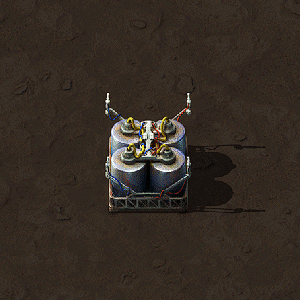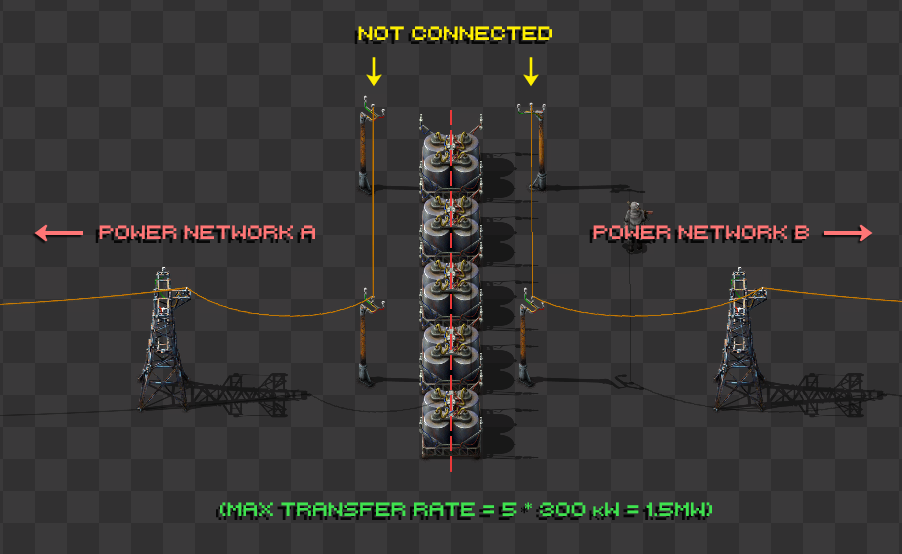User talk:HR248: Difference between revisions
Tag: Rollback |
mNo edit summary |
||
| Line 1: | Line 1: | ||
''' | {{Languages}}{{:Infobox:Accumulator}} | ||
Ein '''Akkumulator''' speichert eine begrenzte Menge Energie, wenn die Produktion den Verbraucht übersteigt, und stellt diese umgekehrt wieder zur Verfügung. Er kann maximal 5 MJ speichern, bei einer maximalen Ladung/Entladung von 300 kW. Wird der Akkumulator mit einem Netzwerk verbunden, gibt er seine prozentuale Ladung von 0 bis 100 als spezifisches Signal aus. | |||
== Bemerkungen == | |||
* 5MJ gespeicherte Energie benötigen etwa 17s, um vollständig ge-/entladen zu werden. Siehe auch [[Game-second/de|Spiel-Sekunde]] für weitere Berechnungen. | |||
* It takes 20 accumulators (100MJ) to maintain 1MW through the night, because the accumulators don't immediately start discharging at the beginning of dusk, see the graph in [https://forums.factorio.com/viewtopic.php?f=5&t=5594 this post.] | |||
* When discharged above maximum speed by multiple unconnected poles, energy will not be distributed equally (some loads may get 100% demand, others 0%) | |||
* May be used to provide a limited amount of power (multiples of maximum charge rate) to a section of the grid. | |||
* Produces light when charging and discharging. | |||
* Can act as an emergency backup for the factory in case of blackout, until main power supply is restored. | |||
* Can be used to power the base at night if it relies heavily on [[solar panel]]s. | |||
* Can act to satisfy surging demands of certain loads. If the power usage of one device exceeds production for a few seconds or so, the accumulator can provide power to the grid until said device shuts down or requires a lesser power requirement. | |||
== Other uses == | |||
Note that if you don't want to limit throughput you can use a [[power switch]] instead. | |||
== | === Isolation of Power Networks === | ||
[[Electric system#Storage|Accumulator]]s can be used to isolate two separate power networks, which has a number of uses. Since accumulators have a lower delivery priority than any other entity, this guarantees that they only receive energy when you have enough left over after powering all other entities in a network. At the same time, accumulators can also be used to deliver energy in another electrical network, and can charge and discharge at the same time. Consider the following example: | |||
[[File:Accumulator_Network_Isolation.png]] | |||
The two power networks A and B are not directly connected to each other: They are connected only through the accumulators, which are shared by both networks. This is accomplished by setting up electric poles for each network connected to the accumulators, then ensuring the sets of poles are not connected to each other (which can be done by crafting a copper wire then dragging it between two connected poles to sever the connection, exactly as is done for disconnecting circuit wires). | |||
In the above example: | |||
* The accumulators will only charge if extra power is being produced by network A or B. | |||
* | * The accumulators will discharge as needed into either network if one is not producing enough power. | ||
* | * Since the maximum input/output rate of an accumulator is 300 kW, power flow between the two networks will be limited to 300 kW times the number of accumulators (1.5 MW in the example). | ||
* | * Note that this isolation is bidirectional: Either network can charge the accumulators, and the accumulators can discharge into either network. | ||
This technique can be used whenever this type of isolation is desired. | |||
==== Reduction of Energy Consumption in Critical Situations ==== | |||
In particular, one good use for the above technique is to limit electricity consumption in low power situations by isolating non-critical parts of your factory (such as [[Radar]], [[Lab]]s, [[Electric furnace]]s, [[Electric mining drill|electric miner]]s, [[Beacon]]s, etc.) from critical parts (such as lasers, ammo production, or whatever your priorities are). | |||
To do this, place your main generators and critical components on one network and place your non-critical components on another network, isolating the two as above. Now, two things will happen: | |||
* Power will ''only'' flow to the non-critical network when you are generating a surplus on the main network, and | |||
* The rate will always be limited to 300 kW per accumulator. | |||
Because the accumulators will only receive power if you have a surplus on the main network, this will in effect deactivate the low-priority network when electricity is in short supply. This will also limit power consumption of the low priority network if its usage becomes high, for example if you have two factories on a low priority network and usually only one of them runs at a time, if both happen to run they won't consume more than the total limit, they'll just slow down. | |||
Essentially you are saying "only deliver power to these systems if I have enough to spare, and even then don't exceed this delivery rate". | |||
In general this is a technique which works well when you've just researched accumulators and solar panels, but don't have enough resources to build big solar farms and accumulator farms yet. | |||
=== | == History == | ||
{{history|0.13.3| | |||
* Reduced collision box of [[big electric pole]] to allow squeezing between it and an accumulator.}} | |||
{{history|0.13.0| | |||
* Now connectible to the circuit network.}} | |||
* | |||
{{history|0.12.0| | |||
* Heavy optimisations by merging them into groups.}} | |||
{{history|0.11.0| | |||
* Drastically slowed crafting to 10 secs.}} | |||
{{history|0.7.1| | |||
* Capacity doubled, increase I/O to 300 watts.}} | |||
{{history|0.4.1| | |||
* Added charging animation.}} | |||
{{history|0.4.0| | |||
* Introduced}} | |||
== See also == | |||
* [[Electric system]] | |||
* [[Solar panel]] | |||
* [[Power production]] | |||
* [[Game-day]] | |||
{{ProductionNav}} | |||
{{C|Energy}} | |||
Revision as of 22:15, 22 October 2018
| HR248 |
|
Recipe |
|
| + + → | |
|
Total raw |
|
| + + |
|
Map color |
|
|
Health |
150 |
|
Stack size |
50 |
|
Dimensions |
2×2 |
|
Energy capacity |
5.0 MJ (electric) |
|
Power input |
300 kW |
|
Power output |
300 kW |
|
Mining time |
0.1 |
|
Prototype type |
|
|
Internal name |
accumulator |
|
Required technologies |
|
|
Produced by |
|
|
Consumed by |
|
Ein Akkumulator speichert eine begrenzte Menge Energie, wenn die Produktion den Verbraucht übersteigt, und stellt diese umgekehrt wieder zur Verfügung. Er kann maximal 5 MJ speichern, bei einer maximalen Ladung/Entladung von 300 kW. Wird der Akkumulator mit einem Netzwerk verbunden, gibt er seine prozentuale Ladung von 0 bis 100 als spezifisches Signal aus.
Bemerkungen
- 5MJ gespeicherte Energie benötigen etwa 17s, um vollständig ge-/entladen zu werden. Siehe auch Spiel-Sekunde für weitere Berechnungen.
- It takes 20 accumulators (100MJ) to maintain 1MW through the night, because the accumulators don't immediately start discharging at the beginning of dusk, see the graph in this post.
- When discharged above maximum speed by multiple unconnected poles, energy will not be distributed equally (some loads may get 100% demand, others 0%)
- May be used to provide a limited amount of power (multiples of maximum charge rate) to a section of the grid.
- Produces light when charging and discharging.
- Can act as an emergency backup for the factory in case of blackout, until main power supply is restored.
- Can be used to power the base at night if it relies heavily on solar panels.
- Can act to satisfy surging demands of certain loads. If the power usage of one device exceeds production for a few seconds or so, the accumulator can provide power to the grid until said device shuts down or requires a lesser power requirement.
Other uses
Note that if you don't want to limit throughput you can use a power switch instead.
Isolation of Power Networks
Accumulators can be used to isolate two separate power networks, which has a number of uses. Since accumulators have a lower delivery priority than any other entity, this guarantees that they only receive energy when you have enough left over after powering all other entities in a network. At the same time, accumulators can also be used to deliver energy in another electrical network, and can charge and discharge at the same time. Consider the following example:
The two power networks A and B are not directly connected to each other: They are connected only through the accumulators, which are shared by both networks. This is accomplished by setting up electric poles for each network connected to the accumulators, then ensuring the sets of poles are not connected to each other (which can be done by crafting a copper wire then dragging it between two connected poles to sever the connection, exactly as is done for disconnecting circuit wires).
In the above example:
- The accumulators will only charge if extra power is being produced by network A or B.
- The accumulators will discharge as needed into either network if one is not producing enough power.
- Since the maximum input/output rate of an accumulator is 300 kW, power flow between the two networks will be limited to 300 kW times the number of accumulators (1.5 MW in the example).
- Note that this isolation is bidirectional: Either network can charge the accumulators, and the accumulators can discharge into either network.
This technique can be used whenever this type of isolation is desired.
Reduction of Energy Consumption in Critical Situations
In particular, one good use for the above technique is to limit electricity consumption in low power situations by isolating non-critical parts of your factory (such as Radar, Labs, Electric furnaces, electric miners, Beacons, etc.) from critical parts (such as lasers, ammo production, or whatever your priorities are).
To do this, place your main generators and critical components on one network and place your non-critical components on another network, isolating the two as above. Now, two things will happen:
- Power will only flow to the non-critical network when you are generating a surplus on the main network, and
- The rate will always be limited to 300 kW per accumulator.
Because the accumulators will only receive power if you have a surplus on the main network, this will in effect deactivate the low-priority network when electricity is in short supply. This will also limit power consumption of the low priority network if its usage becomes high, for example if you have two factories on a low priority network and usually only one of them runs at a time, if both happen to run they won't consume more than the total limit, they'll just slow down.
Essentially you are saying "only deliver power to these systems if I have enough to spare, and even then don't exceed this delivery rate".
In general this is a technique which works well when you've just researched accumulators and solar panels, but don't have enough resources to build big solar farms and accumulator farms yet.
History
- 0.13.3:
- Reduced collision box of big electric pole to allow squeezing between it and an accumulator.
- 0.13.0:
- Now connectible to the circuit network.
- 0.12.0:
- Heavy optimisations by merging them into groups.
- 0.11.0:
- Drastically slowed crafting to 10 secs.
- 0.7.1:
- Capacity doubled, increase I/O to 300 watts.
- 0.4.1:
- Added charging animation.
- 0.4.0:
- Introduced

